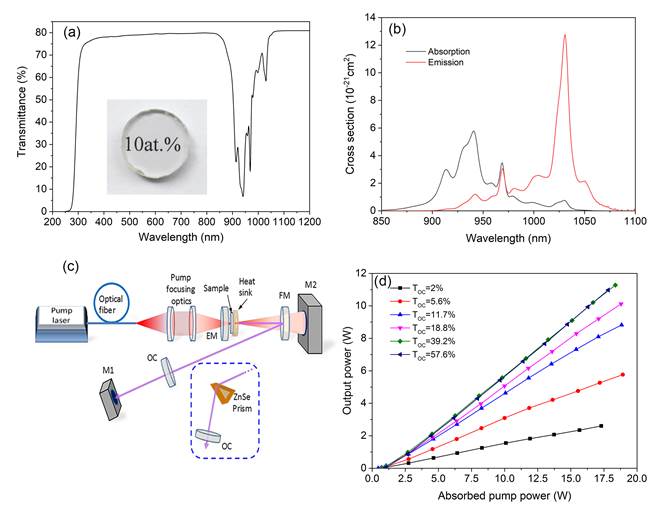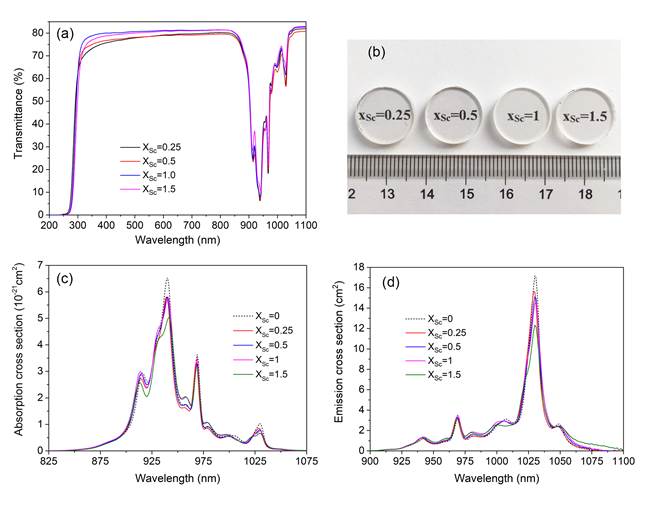Different Component Designs Are Adopted to Achieve the Performance Regulation on Yttrium Scandium Aluminum Garnet Laser Ceramics
Yttrium aluminum garnet (Y3Al5O12, YAG) is a kind of solid laser matrix material with excellent performance, which features wide light transmission range, high theoretical transmittance and high thermal conductivity et al. In the YAG matrix, Y3+ occupying in the dodecahedral sites and Al3+ occupying in the octahedral and tetrahedral sites can be replaced by other ions with similar properties to form multi-component garnet materials, realizing the regulation of its performance, so as to achieve the multi-functional applications. The introduction of Sc3+ in YAG matrix material forming Y3ScxAl5-xO12 (0≤x≤2) increase the fluctuation of crystal field, resulting in the nonuniform broadening of the Yb3+ emission peak, which is conducive to the generation of ultrafast femtosecond pulse laser. Thus, it is an effective way to achieve the performance regulation through component design.
The research team from Shanghai Institute of Ceramics, Chinese Academy of Sciences led by Prof. LI Jiang, has made a series of progress in the research of Yb:YSAG laser ceramics. The team has successfully prepared 10 at.% Yb: Y3ScAl4O12 laser ceramics by solid state reaction sintering and hot isostatic pressing (HIP) technology. The full width of half maximum (FWHM) of the emission peak at 1030nm of Yb3+ is about 1.3 times larger than that of 10 at.% Yb:YAG, which is very conducive to the generation of ultrafast femtosecond pulse laser.
In cooperation with the Istituto di Fisica Applicata “Carrara” (IFAC) and Istituto Nazionale di Ottica (INO) Consiglio, Nazionale delle Ricerche (CNR) of Italy, the researchers realized the high efficiency laser output of Yb:Y3ScAl4O12 ceramics. Using the 929.4nm fiber coupled laser diode (LD) pumping, Quasi Continuous-Wave (QCW) laser output with slope efficiency of 67.6% and output power of 11.3W (the maximum reported laser output power for this material at present) was realized. The result was published in the Journal of the American Ceramic Society (J. Am. Ceram. Soc., 2019, DOI: 10.1111/jace. 16691).
Meanwhile, the team studied the influences of Yb3+ doping concentration on the microstructure and optical properties of Yb:Y3ScAl4O12 laser ceramics. The 10 at.% Yb:Y3ScAl4O12 laser ceramics show the best optical quality and laser performance. In addition, the influences of different Sc3+ contents on the properties of 10 at.% Yb:Y3ScxAl5-xO12 ceramics were also investigated. With the increase of Sc3+ content, the FWHM of Yb3+ emission peak increases correspondingly. In particular, the FWHM of the emission peak at 1030nm for the 10 at.% Yb:Y3ScxAl5-xO12 ceramics with Sc3+ content of 1.5 is 1.4 times larger than that of 10 at.% Yb:YAG ceramics, which can generate about 100fs pulse laser theoretically. The laser performance of 10 at.% Yb:Y3Sc1.5Al3.5O12 transparent ceramics was tested. A QCW laser output power of 10.8W with the corresponding slope efficiency of 66.4% was obtained, and the tunable laser wavelength range was 86.2nm (988-1074.2nm). It is the largest laser tuning range ever reported for Yb:YSAG ceramics (J. Alloys. Compd., 2020, 815: 152637).
In addition, the team cooperated with Prof. LI Wenxue from East China Normal University, and realized the high-efficiency continuous laser output of the 10 at.% Yb:Y3Sc1.5Al3.5O12 ceramics by using plano-plano laser resonator and three-mirror laser resonator (Opt. Mater., 2019, 88: 339-344).
The team also prepared high-quality 4 at.% Tm:Y3ScAl4O12 transparent ceramics by vacuum sintering. They have achieved the first 2μm laser output of this new ceramic material through a 790nm fiber coupled LD pumping. The laser wavelength was 2015nm, and the maximum laser output power was 0.54W, whose corresponding slope efficiency is 4.8% (J. Am. Ceram. Soc., 2019, DOI: 10. 1111/jace. 16873). Yb: YSAG laser ceramics are mainly used for 1μm laser generation. The 2 μm mid infrared laser is a very important laser source. It can be absorbed by water, safe for human eyes, transmitted by quartz fiber and transmitted through the atmosphere with high transmittance. Tm3+ ion is a commonly used active ion in 2μ m mid infrared laser. Compared with Tm:YAG ceramic, Tm:YSAG ceramics have a longer fluorescence life time, which is suitable for energy storage. So, the Tm:YSAG ceramics are promising gain media for mid infrared laser.
The relevant research work has been supported by the Key Research Program of the Chinese Academy of Sciences, the National Natural Science Foundation of China, the National Key R&D Program of China, and the key discipline construction project of Shanghai Institute of Ceramics, Chinese Academy of Sciences.

(a) In-line transmittance and physical photo; (b) absorption and emission cross sections; (c) laser device diagram; (d) QCW laser performance of the 10 at.% Yb:Y3ScAl4O12 laser ceramics.

(a) In-line transmittances; (b) physical photos; (c) absorption cross section; (d) emission cross section of the 10 at.% Yb:Y3ScxAl5-xO12 laser ceramics with different Sc3+ contents.

(a) In-line transmittance and physical photo; (b) absorption cross section; (c) emission cross section; (d) laser device diagram and laser performance of the 4 at.% Tm:Y3ScAl4O12 laser ceramics.
Reference:
1)https://ceramics.onlinelibrary.wiley.com/doi/10.1111/jace.16691
2)https://www.sciencedirect.com/science/article/pii/S0925838819338836
3)https://www.sciencedirect.com/science/article/pii/S0925346718308097
4)https://ceramics.onlinelibrary.wiley.com/doi/10.1111/jace.16873
Contact:
Prof. LI Jiang
Shanghai Institute of Ceramics, CAS
lijiang@mail.sic.ac.cn



